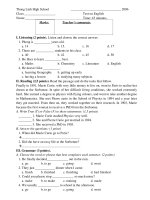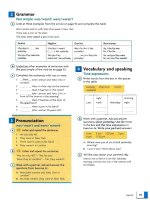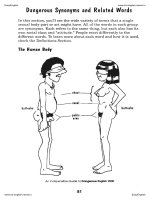Math test english 10 potx
Bạn đang xem bản rút gọn của tài liệu. Xem và tải ngay bản đầy đủ của tài liệu tại đây (481.33 KB, 6 trang )
26. Choice f is correct. Subtract the numbers in y from the corresponding numbers in x.
[]
=
[]
27. Choice b is correct. log
3
x = 2 is equivalent to 3
2
= x. Therefore, x = 9.
28. Choice h is correct. Factor the numerator. Use the denominator as a clue. Most likely, one of the fac-
tors in the numerator will be the same as the denominator. Also, notice that the numerator is the dif-
ference of two squares.
ᎏ
(x −
x
3)
−
(x
3
+3)
ᎏ
The x − 3 in the numerator cancels with the x − 3 in the denominator leaving an answer of x + 3.
29. Choice b is correct. Use the distance formula or the Pythagorean theorem to find the distance. The dis-
tance formula is d = ͙(x
2
− x
ෆ
1
)
2
+ (y
ෆ
2
− y
1
)
2
ෆ
. Substitute the x and y values for points A and C and
solve.
d = ͙(−2 −−
ෆ
1)
2
+ (
ෆ
−1 − 3
ෆ
)
2
ෆ
d = ͙(−1)
2
+
ෆ
(−4)
2
ෆ
d = ͙1 + 16
ෆ
d = ͙17
ෆ
To use the Pythagorean theorem (which is what the distance formula is derived from), draw the seg-
ment on a coordinate plane and create a right triangle where A
ෆ
C
ෆ
is the hypotenuse.
The legs of the right triangle are 1 and 4. Use the Pythagorean theorem to find the length of the
hypotenuse.
a
2
+ b
2
= c
2
1
2
+ 4
2
= c
2
1 + 16 = c
2
17 = c
2
͙17
ෆ
= c
(−1,3)
(−2,−1)
1
4
50
66
3 − ( − 2) 4 − 4
5 − ( − 1) 6 − 0
– ACT MATH TEST PRACTICE–
189
30. Choice f is correct. Since the line is parallel to 3y − 9x = 24, they have the same slope. Put the equation
into y = mx + b form to easily see the slope:
3y − 9x = 24
3y = 9x + 24
y = 3x + 8
The equation above indicates that the slope is 3. The line you are looking for also has a slope of 3.
You are looking for the line y = 3x + 4. You must put the answer choices in y = mx + b form to com-
pare them to this equation. Equation f is correct.
f. y = 3x + 4
g. y = 3x + 5
h. y = 2x + 4
i. y = 2x + 1
j. y = −
ᎏ
1
3
ᎏ
x −
ᎏ
1
9
4
ᎏ
31. Choice d is correct. You are looking for an x and a y value. The x value must be 9 since one of the
equations is x = 9. To find y, substitute 9 for x in the second equation.
3(9) + y = 4
27 + y = 4
y = −23
The ordered pair is (9, −23). This point is a solution to both equations.
32. Choice i is correct. ͙37
ෆ
is close to ͙36
ෆ
, which is 6. ͙125
ෆ
is close to ͙121
ෆ
, which is 11; (6)(11) = 66.
33. Choice d is correct. The equation is quadratic, so it can be solved by either setting the equation equal
to zero and factoring or using the quadratic formula. In this case, factoring is the easiest option. First,
set the equation equal to zero:
x
2
− 6x − 27 = 0
(x − 9)(x + 3) = 0
x − 9 = 0 x + 3 = 0
x = 9 x = −3
The solution set is {−3, 9}.
34. g. Find the probability of each event and multiply the answers to find the probability of both events
occurring. The probability of getting tails is
ᎏ
1
2
ᎏ
and the probability of rolling a 3 is
ᎏ
1
6
ᎏ
;(
ᎏ
1
2
ᎏ
)(
ᎏ
1
6
ᎏ
) =
ᎏ
1
1
2
ᎏ
.
The probability of getting tails and rolling a 3 is
ᎏ
1
1
2
ᎏ
.
35. Choice d is correct. Multiply the decimal equivalent of
ᎏ
1
2
ᎏ
% by 90. The decimal equivalent of
ᎏ
1
2
ᎏ
% is
0.005. (0.005)(90) = 0.45.
36. Choice j is correct. ͙41
ෆ
lies between ͙36
ෆ
, which is 6 and ͙49
ෆ
, which is 7. It lies between 6 and 7.
– ACT MATH TEST PRACTICE–
190
37. Choice e is correct. Think about what you would do if he used 2 bags for each pizza.
12 ÷ 2 = 6 pizzas. Follow the same pattern and divide the 12 bags by
ᎏ
3
4
ᎏ
.
12 ÷
ᎏ
3
4
ᎏ
=
ᎏ
1
1
2
ᎏ
×
ᎏ
4
3
ᎏ
=
ᎏ
4
3
8
ᎏ
= 16
Mike can make 16 pizzas.
38. Choice g is correct. Convert the given rate of meters per second to kilometers per hour.
ᎏ
1
9
0
.7
0
9
m
s
ᎏ
×
ᎏ
1
1
00
k
0
m
m
ᎏ
×
ᎏ
1
6
m
0s
in
ᎏ
×
ᎏ
60
1
m
h
in
ᎏ
=
ᎏ
360
9
,
.
0
7
0
9
0
0h
km
ᎏ
=
ᎏ
36.8
h
km
ᎏ
Round the answer to 37 km/h.
39. Choice c is correct. Originally, Larry had 20 socks in the drawer. Since he pulled a red one out already,
there are only 19 left in the drawer and 5 of them are red.
P(red) =
ᎏ
#
to
r
t
e
a
d
l
ᎏ
=
ᎏ
1
5
9
ᎏ
40. Choice i is correct. Multiply the 5 and 6 to get 30. Then, multiply the powers of 10. 10
−4
× 10
8
= 10
4
.
Since the bases are the same, you can just add the exponents. So far you have 30 × 10
4
, but this is not
an answer choice. Change your answer to scientific notation by moving the decimal in 30 to 3.0. Since
the decimal has been moved one place to the left, you must increase the power of 10 by one. Therefore,
the answer is 3 × 10
5
.
41. b. sin =
ᎏ
hy
o
p
p
o
p
t
o
e
s
n
it
u
e
se
ᎏ
. First, find the hypotenuse by using the Pythagorean theorem, or noticing that it is a
3-4-5 triangle (multiplied by 2). Therefore, the missing side is 5 × 2= 10. sin B =
ᎏ
1
6
0
ᎏ
=
ᎏ
3
5
ᎏ
.
42. Choice h is correct. Use the formula tan =
ᎏ
a
o
d
p
j
p
a
o
c
s
e
i
n
te
t
ᎏ
. tan x =
ᎏ
4
3
ᎏ
.
43. Choice d is correct. There are 3 pairs of sides. The two sides that measure 6 × 8 each have an area of 48.
The two sides that measure 6 × 10 each have an area of 60. The two sides that measure 8 × 10 each
have an area of 80. Since there are two of each side, multiply the area of each by 2, then add the areas.
48 × 2 = 96
60 × 2 = 120 96 + 120 + 160 = 376
80 × 2 = 160
44. Choice j is correct. The radius of the large circle is 7 (add the inner radius plus the extra 3 from the
ring). Therefore, the area of the large circle is 49π. Subtract the area of the inner circle, which is 16π.
49π−16π = 33π.
– ACT MATH TEST PRACTICE–
191
45. Choice a is correct. Take the square root of the area to find the length of one side. ͙100
ෆ
= 10, so the
length of the sides of the square is 10 centimeters. When the diagonal is drawn it creates a right trian-
gle with legs of 10 cm each and the diagonal is the hypotenuse.
Use the Pythagorean theorem to find the diagonal.
10
2
+ 10
2
= x
2
100 + 100 = x
2
200 = x
2
͙200
ෆ
= x
10͙2
ෆ
= x
46. Choice i is correct. Use the Pythagorean theorem to find the hypotenuse.
a
2
+ b
2
= c
2
4
2
+ 9
2
= c
2
16 + 81 = c
2
97 = c
2
͙97
ෆ
= c
47. Choice c is correct. The formula for area of a circle is A = πr
2
. Change the radius to an improper frac-
tion; 3
ᎏ
1
2
ᎏ
=
ᎏ
7
2
ᎏ
. Use the formula to find the area using the improper fraction. A = π(
ᎏ
7
2
ᎏ
)
2
=
ᎏ
4
4
9
ᎏ
π. The area is
ᎏ
4
4
9
ᎏ
π square inches.
48. Choice f is correct. Substitute 15 for y in the equation and solve for x.
y = 4x
2
− 1
15 = 4x
2
− 1
16 = 4x
2
4 = x
2
2 = x
49. Choice e is correct. Find the number of students that voted for Kristen (male and female) by multiply-
ing 540 by the decimal equivalent of 60%. 540 × 0.60 = 324. 324 students voted for Kristen. Find 75%
of that number. 324 × 0.75 = 243. 243 females voted for Kristen.
10 cm
10 cm
10 cm 10 cm
YX
Z W
– ACT MATH TEST PRACTICE–
192
50. Choice f is correct. Use the identity tanθ =
ᎏ
c
si
o
n
s
θ
θ
ᎏ
.
ᎏ
5
6
ᎏ
=
Multiply both sides by
ᎏ
1
6
7
ᎏ
to isolate the sinθ.
ᎏ
1
6
7
ᎏ
×
ᎏ
5
6
ᎏ
= sinθ
ᎏ
1
5
7
ᎏ
= sinθ
51. Choice d is correct. The original formula was V = lwh. If each dimension is tripled, the length is 3l, the
width is 3w, and the height is 3h. When these values are substituted into the equation, the equation
becomes V = (3l)(3w)(3h) or V = 27lwh. Thus, the new rectangular solid has a volume 27 times the
original volume.
52. Choice j is correct. The sum of the measures of the angles in a triangle is 180°. In a right triangle, the
right angle is 90°, so another 90° is split between the remaining two angles.
7x + 8x = 90
15x = 90
x = 6
The value of x is 6, but the question asks for the measure of the smaller angle, which is 7x. Substituting
in 6 for x, yields (7)(6) = 42. The measure of the angle is 42°.
53. Choice c is correct. Use the Pythagorean theorem to find the missing leg.
a
2
+ b
2
= c
2
9
2
+ x
2
= 10
2
81 + x
2
= 100
x
2
= 19
x = ͙19
ෆ
The length of the missing side is ͙19
ෆ
.
54. Choice j is correct. Call the width w and the length 2w. The perimeter is then
P = w + w + 2w + 2w
72 = 6w
12 = w
The width is 12. Since the length is twice the width, the length is 24.
sinθ
ᎏ
– ACT MATH TEST PRACTICE–
193
55. Choice e is correct. Three of the answer choices can be immediately eliminated because the length of
the height cannot be negative. Answer choices b, c, and d all have negative lengths.
Call the height h and the base h + 5. The area of a triangle is
ᎏ
b
2
h
ᎏ
. Substitute in h and h + 5 for the base
and height, and set the area equal to 80 since the are of the given triangle is 80;
ᎏ
h(h
2
+5)
ᎏ
= 80
Solve for h. The equation is quadratic, so the quadratic formula will be used;
ᎏ
h
2
+
2
5h
ᎏ
= 80
h
2
+ 5h = 160
h
2
+ 5h − 160 = h
Use the quadratic formula to solve.
The negative value is eliminated from the answer because it does not make sense. The answer is
.
56. Choice i is correct. The easiest way to find the length of one side is to draw the square on the coordi-
nate plane and count the spaces. There are 7 spaces between (−2, 3) and (5, 3). Therefore, the length of
a side is 7.
The distance formula can also be used. First, you must decide which points are consecutive vertices of
the square. Let’s use (−2, 3) and (5, 3). The distance formula is then:
d = ͙(5 − (−
ෆ
2))
2
+
ෆ
(3 − 3)
ෆ
2
ෆ
d = ͙7
2
+ 0
ෆ
d = ͙49
ෆ
d = 7
(−2,3) (5,3)
(−2,−4) (5,−4)
7
−5 + ͙665
ෆ
ᎏᎏ
2
−5 ± ͙665
ෆ
ᎏᎏ
2
−5 ± ͙25 + 6
ෆ
40
ෆ
ᎏᎏ
2
−5 ± ͙(5)
2
−
ෆ
4(1)(−
ෆ
160)
ෆ
ᎏᎏᎏ
2(1)
– ACT MATH TEST PRACTICE–
194









